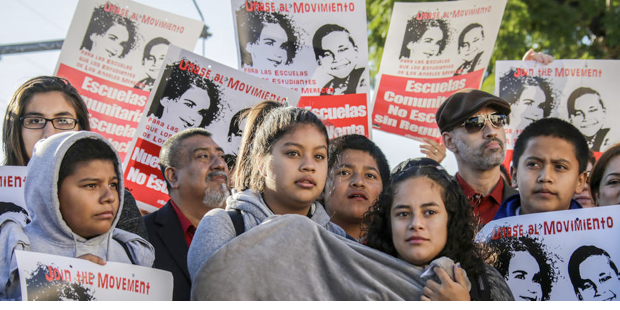CommentsEDUCATION POLITICS-Charter schools are, in fact, the new face of segregation, the enabling excuse for exclusivity and alienation. The Charter School movement glorifies the illusion of “choice” even while entitling homogeneity.
This is borne out in the numbers and confessed every day via parent-to-parent euphemisms: “this school is a better ‘fit',” “‘safety’ is my top priority,” “my child only responds to a ‘nurturing environment',” “smaller class sizes are necessary for my child,” “I want my child immersed in a specialized program.”
So much sorting and selecting sets up a double whammy for segregation. On one level families self-select according to like-mindedness and socioeconomic comfort level. At the same time the very process of school selection siphons highly involved families away from public district schools.
This in itself is a big deal, to sequester families as a function of education engagement, thereby isolating their children from any cross-fertilizing influence and nourishing a wake of alienation that inhibits social mobility.
But the important point is that the act of “choice” itself drives this segregating process, and it does so with ruthless efficiency. What results is a fractionated landscape with those favoring certain school types or societies isolated in enclaves by proclivity or status, and the remainder being those disinclined to sorting (i.e., “not-engaged” parents) or otherwise actively excluded from the assortment (e.g., special education students).
The problem arises from the conceit that these particular highly touted choices can be mutually exclusive without penalty. And it is by virtue of this pretense that they are -- that exclusivity is excused and empowered.
For example, when you say “my child does better in small classes,” an implication is asserted tacitly that another’s child does not (that, say, my child does not.) This sets up a false dichotomy of mutual exclusion where separate circumstances could be considered equal by virtue of “choice”. That is, where smaller class sizes might be considered essential for one set of children and inessential for another.
Except segregation in terms of this “choice” does not result in reasonably equivalent conditions since it is not true that the benefit of class size is conditional; pedagogy improves with smaller class sizes for everyone. So while class size is a prime motivator for parents in selecting a Charter school, the presence of this very choice itself confers selectivity and exclusivity necessarily. By definition. “Choice” confers winners and “choice” also confers losers. “Choice” enables, enforces and excuses elitism.
In fact all these “choices” are actually restrictions, because all the euphemisms are also truisms: who would not choose “safety”, who would reject a nurturing environment, who denies that the “fit” of a school is optimized by excluding those who do not fit?
The institution of school “choice” affirms a virtue of exclusion. To lean toward Charters is to revere a future we already rejected in the past, when segregation was named as something wicked and ruled unconstitutional.
Hence the utility of euphemisms today. Like a stinking rose, segregation by any other name would conquer as it divides.
And let’s be very clear about this: Charter schools do divide the body politic. They alienate whole classes of families and children from one another, holding public education hostage to the conquering ideology of vouchers and neoliberal racketeering.
(Sara Roos is a politically active resident of Mar Vista, a biostatistician, the parent of two teenaged LAUSD students and a CityWatch contributor, who blogs at redqueeninla.com) Prepped for CityWatch by Linda Abrams.

















